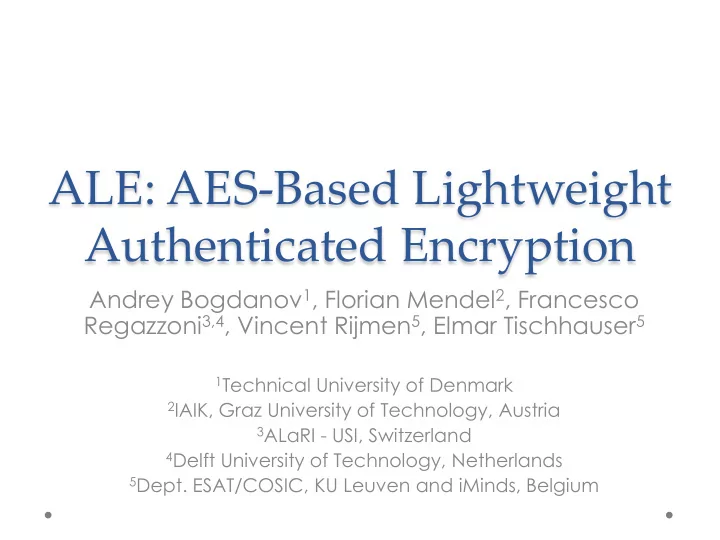

ALE: AES-Based Lightweight Authenticated Encryption Andrey Bogdanov 1 , Florian Mendel 2 , Francesco Regazzoni 3,4 , Vincent Rijmen 5 , Elmar Tischhauser 5 1 Technical University of Denmark 2 IAIK, Graz University of Technology, Austria 3 ALaRI - USI, Switzerland 4 Delft University of Technology, Netherlands 5 Dept. ESAT/COSIC, KU Leuven and iMinds, Belgium
Authenticated Encryption (AE) • Is cryptography about encryption? Yes, but not only! o Encryption alone is not enough in numerous applications o One might even argue that authentication is really what is needed in o most cases • Authenticated encryption AE: (P,K) -> (C,T) with T authentication tag • Authenticated encryption with associated data AEAD: (A,P,K) -> (A,C,T) with A associated data transmitted in plaintext
The assumption of nonce • Nonce N = number used once, freshness • Nice but might be difficult to enforce in sometimes David McGrew, DIAC’12 slides • Good news: Nonce can be “just” a counter!
[RBBK01] Nonce-based: AES-OCB [BR02] [R02] [R04] [KR11] • Init(N): initialization function • Inc: increment function • Checksum = M1 xor M2 xor... Mn
[RBBK01] Nonce-based: AES-OCB [BR02] [R02] [R04] [KR11] + • 1 AES-128 call per block • perfectly parallelizable • only forgery with nonce reuse • associated data
[RBBK01] Nonce-based: AES-OCB [BR02] [R02] [R04] [KR11] + - • • 1 AES-128 call per block enc/dec different • • perfectly parallelizable state 4x128 bits • • only forgery with nonce reuse (patents pending) • associated data
[JK11] ASC-1
[JK11] ASC-1 + • only 4 AES-128 rounds per block • enc/dec similar
[JK11] ASC-1 + • only 4 AES-128 rounds per block • enc/dec similar - • state 4x128 bits • serial • state recovery with nonce reuse • slow in compact ASIC implementation • no associated data
Our Goal • Design of a dedicated AE scheme which would: o require less operations on average o be compact in hardware (for both encryption and decryption) o have low power and low energy figures o be good in software • PC (AES-NI) • Embedded (usually not parallelizable) o rely on some previous cryptanalysis
ALE = associated data AES = AES-128 = message = 128-bit key = ciphertext = tag Initialization: nonce, AES with master k, 0, AES with master k, AES with ks Processing Associated Data: xor with state, 4R AES Processing Message: xor with message, 4R AES LEX leak
[B06] LEX leak for ALE encryption odd rounds even rounds
ALE = associated data AES = AES-128 = message = 128-bit key = ciphertext = tag Initialization: nonce, AES with master k, 0, AES with master k, AES with ks Processing Associated Data: xor with state, 4R AES Processing Message: xor with message, 4R AES LEX leak Finalization: encrypt with AES
ALE = associated data AES = AES-128 = message = 128-bit key = ciphertext = tag + • only 4 AES-128 rounds per block • enc/dec similar • state 2x128 bits • faster in compact ASIC implementation • associated data
ALE = associated data AES = AES-128 = message = 128-bit key = ciphertext = tag + - • • only 4 AES-128 rounds per block serial • • enc/dec similar state recovery with nonce reuse • state 2x128 bits • faster in compact ASIC implementation • associated data
Assumptions for ALE • Assumption 1. Nonce-respecting adversary: A nonce is only used once with the same master key for encryption • Assumption 2. Abort on verification failure: No additional information returned if tampering is detected (in particular, no plaintext blocks)
Claims for ALE • Claim 1. State recovery: State recovery with complexity = t data blocks succeeds with prob at most t2 -128 • Claim 2. Key recovery: State recovery with complexity = t data blocks succeeds with prob at most t2 -128 , even if state recovered • Claim 3. Forgery w/o state recovery: forgery not involving key/state recovery succeeds with prob at most 2 -128
Lightweight ASIC implementation for ALE • ALE implemented using as base AES architecture the smallest available [Moradi et al., Eurocrypt 2011] • Reference algorithms were implemented using the same starting AES • STMicroelectronics 65 nm CMOS LP-HVT, Synopsis 2009.06, 20 MHz
Lightweight ASIC implementation for ALE
Lightweight ASIC implementation for ALE
Software implementation of ALE • Target platforms: o Sanby Bridge 3.1GHz (using AES-NI) o Embedded (estimated) • Parallel or multiple message at a time • Standard Sandy Bridge desktop @ 3.1 GHz • Repeated 100.000 and averaged
Software implementation of ALE (Sandy Bridge) • cycles per byte (AES-NI)
Software implementation of ALE (Sandy Bridge) • cycles per byte (AES-NI)
Software implementation of ALE (embedded) • Serial constructions usually do not cause large overhead • Estimated 2 to 2.5 time faster than AES-OCB
Conclusions • Dedicated nonce-based AES-based AEAD design • Reuses some cryptanalysis of Pelican-MAC and LEX • Small hardware footprint • Fast software (measured with AES-NI, estimated embedded)
Thank you!
Recommend
More recommend